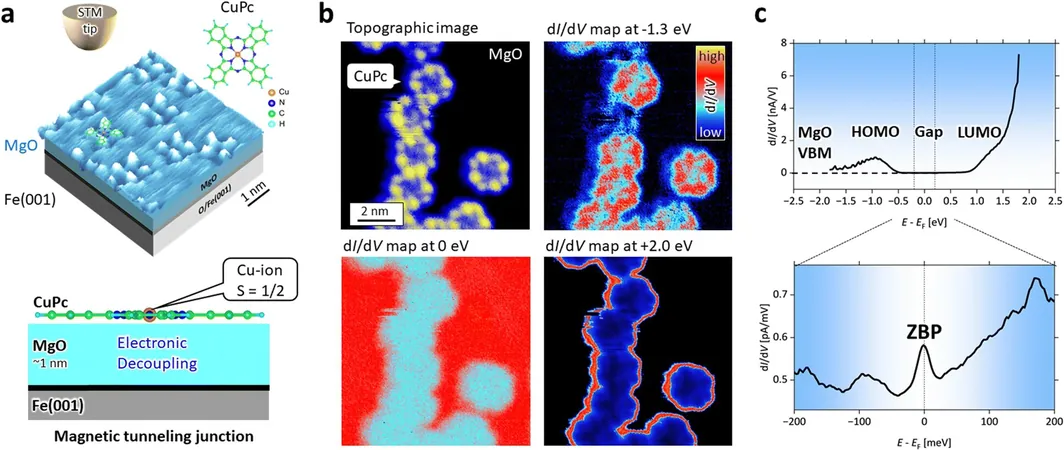
Revolutionary Discovery: Isolated Quantum Spins on Magnetic Substrates Open Doors for Quantum Computing
2025-08-20
Author: Siti
Unlocking the Mystery of Isolated Spins
The quest for stable isolated spins on solid surfaces is turning heads in the world of quantum technology! Isolated spins, which are individual spins shielded from external influences, hold the key to creating efficient quantum bits (qubits), cutting-edge sensors, and advanced single-atom catalysts. Their ability to maintain coherence over time makes them invaluable for quantum computing and ultra-fast spintronic memory.
Material Breakthrough: From Theory to Application
Researchers have long sought materials capable of producing these resilient isolated quantum spins. Prominent candidates include transition metal atoms like copper within copper phthalocyanine (CuPc), molecular magnets, nitrogen-vacancy centers in diamonds, and innovative two-dimensional materials.
The Game-Changing Zero-Bias Peak (ZBP) Method
A pivotal technique for detecting isolated spins involves observing a phenomenon known as the zero-bias peak (ZBP) in the electrical conductance of a substrate embedding CuPc molecules. This peak arises due to interactions between conduction electrons in noble metals and the isolated spins, leading to insightful discoveries.
Gold and Silver: A Double-Edged Sword
While traditional noble metal surfaces like gold and silver have been the go-to for ZBP engineering, they come with a catch—high density of conduction electrons can distort spin states, hampering their effectiveness as qubits. Enter insulating films: researchers are turning to these materials that lack conduction electrons, which are ideal hosts for stable spins.
A Breakthrough Achieved: Isolated Spins on Insulating Surfaces
A landmark study led by Associate Professor Toyo Kazu Yamada from Chiba University, Japan, has successfully engineered isolated spins on insulating magnesium oxide (MgO) laid over a magnetic iron substrate. Dr. Yamada notes, "By utilizing insulating surfaces devoid of conduction electrons, we found that quantum spins can maintain their states more reliably. Plus, our MgO/Fe(001) structure is already a staple in spintronic applications, enhancing its practicality."
Innovative Techniques: Layering for Success
The research team—also composed of Kyoei Ishi, Nana Nazriq, and Peter Krüger—confronted the challenge of depositing an atomically flat MgO layer on an Fe(001) substrate. They discovered that creating an oxygen coating facilitated the attainment of a perfect surface, allowing for the chemical vapor deposition of the MgO film in an ultra-high vacuum.
An Ingenious Shielding Approach
What makes their design truly innovative? The use of a ferromagnetic iron substrate. Normally, magnetic surfaces would interact with isolated spins, altering their states. However, the insulating MgO layer acted as a shield, maintaining spin stability.
Confirming the Spin: Scanning Tunneling Spectroscopy
To verify the existence of isolated spins, the researchers performed scanning tunneling spectroscopy, searching for that elusive ZBP. Initially skeptical due to MgO’s lack of conduction electrons, they were surprised to find a distinct ZBP emerging, indicating indirect coupling between the isolated spin and conduction electrons in the iron substrate.
A New Dawn for Quantum Computing
With ZBPs observed even away from the CuPc on the MgO surface (an anomaly not seen with noble metals), Dr. Yamada enthusiastically states, "This breakthrough signifies a major advancement in isolated spin research! With our MgO/Fe(001) framework already integral to tunnel magnetoresistance devices, we foresee a future where qubits can be integrated seamlessly using current thin-film technology."
The Future is Bright: New Prospects for Quantum Tech
This pioneering research is paving the way for a bright future in quantum computing. By positioning magnetic substrates as robust platforms for qubits, the path is clear for innovative developments in accessible quantum technologies!


 Brasil (PT)
Brasil (PT)
 Canada (EN)
Canada (EN)
 Chile (ES)
Chile (ES)
 Česko (CS)
Česko (CS)
 대한민국 (KO)
대한민국 (KO)
 España (ES)
España (ES)
 France (FR)
France (FR)
 Hong Kong (EN)
Hong Kong (EN)
 Italia (IT)
Italia (IT)
 日本 (JA)
日本 (JA)
 Magyarország (HU)
Magyarország (HU)
 Norge (NO)
Norge (NO)
 Polska (PL)
Polska (PL)
 Schweiz (DE)
Schweiz (DE)
 Singapore (EN)
Singapore (EN)
 Sverige (SV)
Sverige (SV)
 Suomi (FI)
Suomi (FI)
 Türkiye (TR)
Türkiye (TR)
 الإمارات العربية المتحدة (AR)
الإمارات العربية المتحدة (AR)